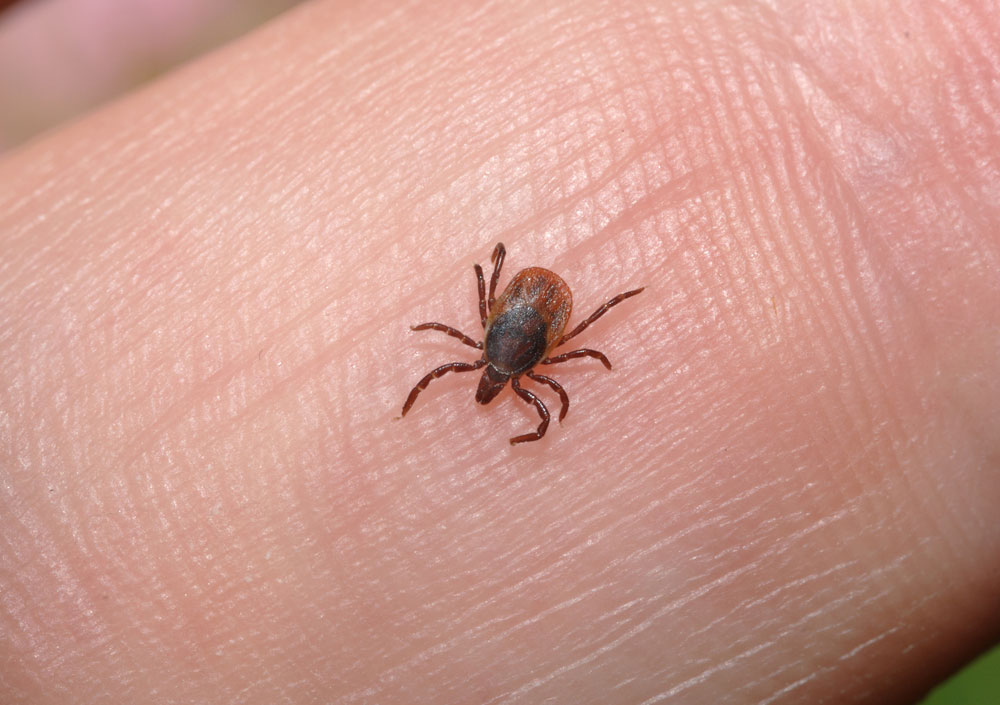Why Do Ticks Spread So Many Diseases?

There's a long list of diseases that you can get from a tick bite, including some that can actually kill you. In fact, the tiny bloodsucking critters can transmit a wider variety of bacteria, viruses and parasites than any other arthropod, a category that includes not only ticks but also insects such as mosquitoes.
More than 80 species of ticks are found in the United States, and about a dozen of these species can bite humans and are considered medically important, said Rebecca Eisen, a research biologist with the Centers for Disease Control and Prevention's Division of Vector-Borne Diseases in Fort Collins, Colorado.
Moreover, infections from tick-borne diseases in the United States are increasing steadily, and the geographic range of ticks that transmit diseases is also expanding, Eisen told Live Science.
Geographically, the greatest expansion of deer ticks (which spread Lyme disease) has been observed in northeastern and north-central states, while remaining stable in southeastern states, according to a recent report on ticks by Eisen and her colleagues published in the Institute for Laboratory Animal Research (ILAR) journal. The expanded range of this tick may be a result of increasing populations of white-tailed deer, increasingly warmer temperatures and reforestation (the replanting of trees), experts say. [10 Important Ways to Avoid Summer Tick Bites]
As ticks spread into new areas and more cases of tick-related illnesses are reported each year, scientists are discovering new disease-causing agents spread by ticks, Eisen said. Since 2000, six new pathogens that cause disease in humans have been recognized in the United States, she said. For example, a new species of bacteria has recently been detected as a cause of Lyme disease in the upper Midwest that has not yet been found in the eastern U.S.
Ticks are known to spread nine bacterial diseases, such as Lyme disease (caused by the bacterium Borrelia burgdorferi) and Rocky Mountain spotted fever (caused by the bacterium Rickettsia rickettsia); four viral infections, including Powassan disease; and one illness linked with a parasite, babesiosis (Babesia microti).
Just three species of ticks are responsible for most U.S. cases of tick-related illness, Eisen said: the blacklegged tick (Ixodes scapularis); the Lone Star tick (Amblyomma americanum) and the American dog tick (Dermacentor variabilis).
Get the world’s most fascinating discoveries delivered straight to your inbox.
The blacklegged tick, also called the deer tick, is found in the northeastern and upper midwestern United States, and can transmit Lyme disease, babesiosis, anaplasmosis and Powassan disease. The Lone Star tick, which is found in the eastern and southeastern U.S., can spread tularemia. And the American dog tick is found mainly east of the Rocky Mountains and can transmit Rocky Mountain spotted fever.
Lyme disease is the most well-known tick-borne illness. People who catch it may develop a red-ringed "bull's-eye" rash, along with flu-like symptoms. As the infection progresses, there may be facial-muscle paralysis or nerve pain. Each year, about 30,000 cases of Lyme disease are reported to the CDC, but because of unreported cases, the actual number of people in the U.S. with the disease is likely 10 times higher, Eisen said.
Troubling trends
What makes ticks so hospitable to such a wide array of disease-causing agents?
Ticks are parasites, so they have to feed on blood in order to reproduce, said Greg Ebel, a professor and director of the Arthropod-borne and Infectious Diseases Laboratory at Colorado State University in Fort Collins. This means ticks often associate with other animals because they need blood from these hosts to survive, he said.
For example, the ticks that are carriers of Lyme disease feed only one time during their larval stage, one time during their nymph stage and once in adulthood, Ebel told Live Science. They need each of these blood meals to molt and develop to their next stage of life, he explained.
Ticks don't have wings, so they can't fly, Ebel noted. In their early stages of development, larvae hang around in leaf piles, looking for mice and birds, and they can acquire infections by feeding on infected hosts, he said. Nymph and adult ticks may crawl onto blades of grass or shrubs. Nymphs may attach to medium-size animals, like chipmunks, and adult ticks may latch onto larger ones, like deer or dogs, Ebel said. [Video: A Tick Bite Visualized]
Ticks typically spread disease by attaching to the skin of the host, which creates a wound, Ebel said; while ticks are taking a blood meal, they spit their infected saliva into the wound.
Adult female ticks may feed on a host for several days, which can increase their chances of picking up a pathogen that they may later pass along. And some disease-causing agents can be passed from infected female ticks into her eggs, so hatching larvae may already be infected.
Tick-bite prevention
Ticks are not specifically adapted to feed on people, Ebel said. For the most part, when a tick bites a human, it's by accident, he said.
If, for example, a person is walking by tall grasses or thick vegetation, and a tick senses movement or warmth or smells carbon dioxide, the tick might attach to a human by mistake, thinking it's an animal capable of giving it a blood meal, Ebel said.
Several factors may be contributing to the rise in tick-borne illnesses. There are more ticks in places where they have always been, and there are now ticks in places where they never were, Ebel said.
More ticks, of course, mean more tick bites.
In turn, there's more transmission of disease-causing agents, but there is also increased awareness of tick-borne diseases among health professionals, as well as improved technologies to diagnose these illnesses, Ebel said.
Prevention can be challenging because ticks are difficult to control, Eisen said. Community-wide strategies to reduce the number of ticks — such as spraying vegetation with pesticides in areas where people are likely to encounter ticks or using deer fencing to keep animals away from homes — have not always been socially acceptable, she said.
But there are some steps people can take on their own to avoid tick bites:
- Know which ticks are common in your area. Avoid places with thick vegetation, tall grass and leaf piles, where ticks often live, Eisen recommended.
- Use insect repellent containingdiethyltoluamide (DEET). Put it on exposed skin when outdoors in areas that may be infested during the spring, summer and early fall, when ticks are most active.Treat clothing and camping gear with the insecticide permethrin, Eisen suggested.
- Check for ticks. Shower as soon as possible after coming indoors, and check your body, clothes and gear for ticks. Treat dogs and cats with a product designed not to bring ticks into the home, Eisen said.
"The sooner a tick is found, the better a person's odds are of not becoming infected," Eisen said.
Originally published on Live Science.
Cari Nierenberg has been writing about health and wellness topics for online news outlets and print publications for more than two decades. Her work has been published by Live Science, The Washington Post, WebMD, Scientific American, among others. She has a Bachelor of Science degree in nutrition from Cornell University and a Master of Science degree in Nutrition and Communication from Boston University.


